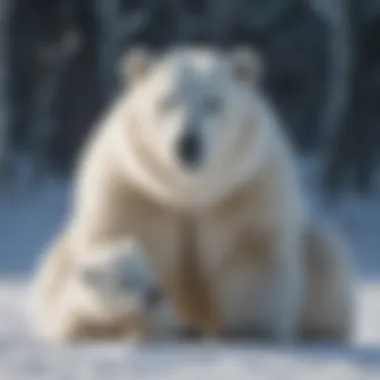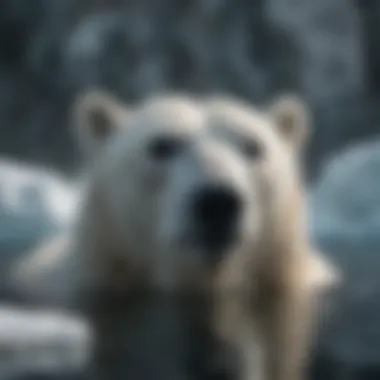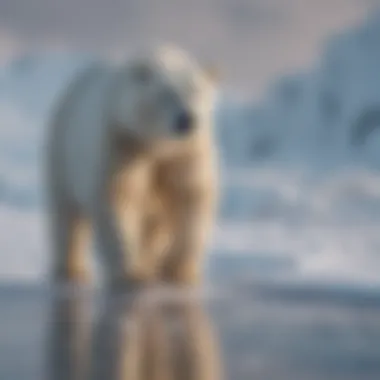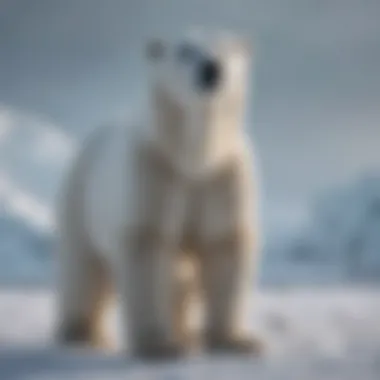Unveiling the Enigmatic World of Polar Bears: An Ultimate Guide for Curious Kids


Nature Topic Overview
As we embark on this educational journey exploring the enchanting world of polar bears, it is essential to delve into the depths of their existence. These intriguing creatures are the epitome of resilience in the face of harsh Arctic conditions. From their majestic size to their thick fur adapted for cold climates, polar bears are a magnificent species worth understanding.
Fun Facts and Trivia
Engaging young minds with captivating tidbits about polar bears can spark a sense of wonder. Did you know that these impressive animals have a layer of blubber under their skin that can be up to 4.5 inches thick to keep them warm in freezing temperatures? Such facts ignite curiosity and create a playful learning environment for children aged 5-12.
Wildlife Explorations
Exploring the habitat of polar bears unveils a rich tapestry of biodiversity. From mighty walruses to elusive arctic foxes, the icy terrain they call home is teeming with life. Introducing young readers to the interconnected web of species in the Arctic ecosystem can foster a deep appreciation for the delicate balance of nature.
Environmental Awareness
Instilling in children a sense of responsibility towards conservation is paramount. Highlighting the importance of sustainable practices and how they directly impact the survival of polar bears can empower the younger generation to be stewards of the environment. Educating kids on simple actions they can take to protect nature ensures a brighter future for these magnificent creatures.
DIY Nature Activities
Encouraging hands-on engagement through nature-inspired activities bridges the gap between learning and application. From creating ice sensory bins to constructing miniature Arctic habitats, these experiential projects provide a tactile way for children to internalize their newfound knowledge about polar bears. Outdoor explorations further reinforce the lessons learned, turning theory into practical, memorable experiences.
Introduction
The world of polar bears is a fascinating realm that captivates the attention of children and adults alike. These magnificent creatures, synonymous with the Arctic wilderness, serve as a crucial element in the delicate balance of the region. Understanding polar bears provides valuable insights into the interconnectedness of ecosystems and the importance of wildlife conservation. This comprehensive guide aims to delve deep into the various facets of polar bear life, shedding light on their behaviors, habitat, diet, and conservation challenges.
Why Polar Bears?
The Significance of Polar Bears in the Arctic Ecosystem
Polar bears play a vital role in the Arctic ecosystem as apex predators, regulating populations of seals and other prey species. Their presence indicates a healthy environment and a thriving ecosystem. These majestic creatures embody strength and resilience, adapting to the harsh Arctic conditions with remarkable expertise.


Curiosity About Polar Bear Behaviors
Exploring polar bear behaviors unveils a world of curiosity and wonder. Their hunting techniques, social interactions, and maternal care demonstrate complex behavioral patterns that intrigue researchers and nature enthusiasts alike. Understanding these behaviors provides keen insights into the adaptive nature of polar bears.
Polar Bears as Symbols of Strength and Resilience
Polar bears symbolize strength and resilience in the face of adversity. Their ability to survive in one of the harshest environments on Earth serves as inspiration for those advocating environmental conservation and wildlife protection. By studying polar bears, one can appreciate the tenacity and fortitude essential for survival in the Arctic.
About Polar Bears
Physical Characteristics of Polar Bears
The physical traits of polar bears, including their thick fur, large paws, and keen sense of smell, are specialized adaptations for Arctic life. These features enable them to navigate icy terrains, hunt effectively, and withstand extreme cold temperatures.
Adaptations for Surviving in the Arctic
Polar bears have evolved remarkable adaptations for survival in the Arctic, such as their insulating fur, efficient hunting skills, and ability to swim long distances. These adaptations highlight the evolutionary prowess of polar bears in adapting to their harsh environment.
Social Structure and Communication
Polar bears exhibit intriguing social dynamics, with solitary tendencies interspersed with social interactions during mating seasons or when hunting in groups. Their communication involves vocalizations, body language, and scent marking, reflecting a complex yet effective system for coordinating behaviors.
Polar Bear Habitat
Arctic Regions: Home of Polar Bears
The Arctic regions serve as the primary habitat for polar bears, offering a vast expanse of sea ice and icy waters crucial for their survival. These remote, icy landscapes provide the perfect environment for polar bears to hunt, mate, and raise their young.
Sea Ice Dependence and Hunting Grounds


Sea ice is integral to the existence of polar bears, as it serves as both their hunting grounds and means of transportation. The retreating sea ice due to climate change poses a significant threat to polar bears, impacting their ability to access food sources and disrupting their natural behaviors.
Climate Change Impact on Polar Bear Habitats
The effects of climate change on polar bear habitats are profound, with shrinking ice cover and changing sea ice patterns threatening the survival of these iconic animals. Understanding these climate-related challenges is crucial for implementing conservation efforts to safeguard the future of polar bears.
Diet and Hunting
Polar Bears' Specialized Diet
Polar bears have a specialized diet primarily consisting of seals, which are rich in energy and essential nutrients for their survival. Their hunting prowess, honed through generations of evolution, enables them to successfully capture seals in the Arctic waters.
Hunting Techniques and Strategies
Polar bears employ various hunting techniques, including stalking, ambushing, and searching for breathing holes in the ice to catch seals. Their strategic approach to hunting reflects their adaptive nature and reliance on sea ice for sustenance.
Role of Seals in Polar Bears' Diet
Seals play a pivotal role in the diet of polar bears, providing a key source of fat and protein necessary for energy conservation and body maintenance. Understanding the intricate relationship between polar bears and seals sheds light on the interconnectedness of Arctic food webs.
Life Cycle and Reproduction
Mating and Pregnancy
The mating rituals and pregnancy cycles of polar bears offer insights into their reproductive strategies and behaviors. Males compete for mating rights, while pregnant females seek out safe birthing dens to give birth to their cubs during the harsh Arctic winter.
Birth of Cubs and Maternal Care
The birth of polar bear cubs heralds a period of intense maternal care and nurturing. Mother polar bears exhibit remarkable devotion to their cubs, providing warmth, protection, and essential nourishment during the vulnerable early stages of cub development.


Cub Development and Survival Challenges
Cub development poses significant challenges, with cubs relying on their mothers for sustenance, protection, and learning essential survival skills. The harsh Arctic environment, coupled with natural predators and food scarcity, tests the resilience of polar bear cubs as they navigate their first years of life.
Conservation Efforts
Threats to Polar Bear Population
Various threats, including climate change, habitat loss, and human impact, pose serious risks to the polar bear population. Understanding these threats is critical for implementing conservation measures that address the root causes endangering these iconic Arctic inhabitants.
International Conservation Efforts
International efforts to conserve polar bears involve cooperation among countries, conservation organizations, and researchers to protect these vulnerable species. Collaborative initiatives, research projects, and policy advocacy aim to mitigate the impacts of climate change and human activities on polar bear populations.
Individual Actions to Protect Polar Bears
Individual actions play a crucial role in protecting polar bears, from advocating for sustainable practices to supporting conservation organizations and raising awareness about the plight of these majestic creatures. Every small effort counts toward preserving the future of polar bears for generations to come.
Wrap-Up
As we conclude this comprehensive guide on polar bears, it is crucial to reflect on the significance of these majestic creatures in the Arctic ecosystem. Polar bears play a vital role as top predators, maintaining the balance of their habitat. Understanding their behaviors and adaptations provides us with insights into the resilience and strength required to thrive in such harsh environments. By highlighting polar bears as symbols of endurance, we can inspire appreciation for the wonders of nature and the importance of conservation efforts. Through this exploration, kids aged 5-12 can gain a deeper understanding of the interconnectedness of all living beings and the urgency of protecting their environment.
Appreciating Polar Bears
Reflecting on the Importance of Polar Bears
Delving into the importance of polar bears allows us to grasp their critical role in the Arctic ecosystem. Reflecting on their significance not only educates us about wildlife preservation but also instills a sense of responsibility towards safeguarding our planet's biodiversity. By emphasizing the uniqueness of polar bears as indicators of environmental health, we underscore the need for proactive conservation measures. This focus on the importance of polar bears encourages a holistic view of ecosystems and fosters a collective effort to protect our natural heritage.
Encouraging Conservation Awareness
Encouraging conservation awareness among children cultivates a sense of environmental stewardship early in life. By highlighting the threats faced by polar bears due to climate change and human encroachment, we nurture empathy and a desire to make a positive impact. Fostering conservation awareness empowers young minds to be mindful of their actions' ecological repercussions, fostering a culture of sustainability and respect for nature's delicate balance. Through education and awareness, we can inspire a generation committed to preserving our planet's natural wonders.
Inspiring Future Generations to Care for Wildlife
Inspiring future generations to care for wildlife sets the foundation for a sustainable future. By igniting a passion for conservation and wildlife protection, we instill values of compassion and responsibility towards all living beings. Empowering children to take action, no matter how small, creates a ripple effect of positive change in communities and beyond. By showcasing the beauty and importance of polar bears and other wildlife, we spark curiosity and a lifelong commitment to environmental conservation. Through these efforts, we ensure a legacy of stewardship and reverence for the rich tapestry of life on Earth.







